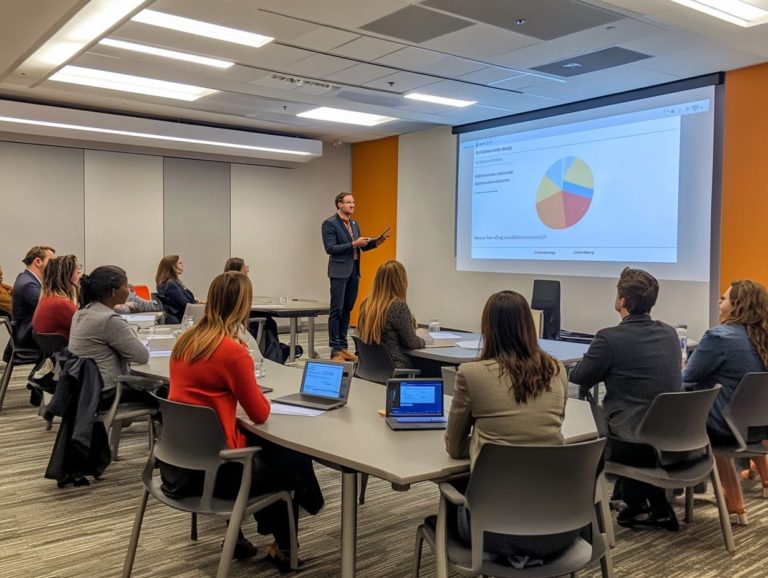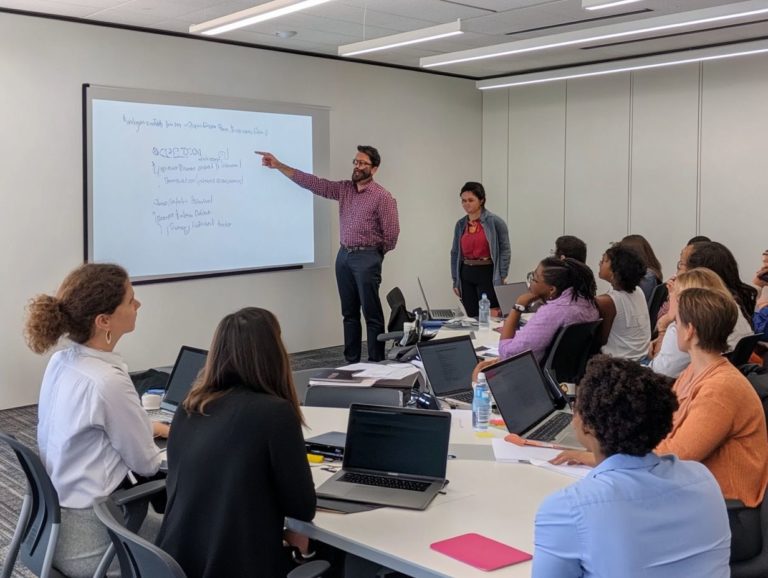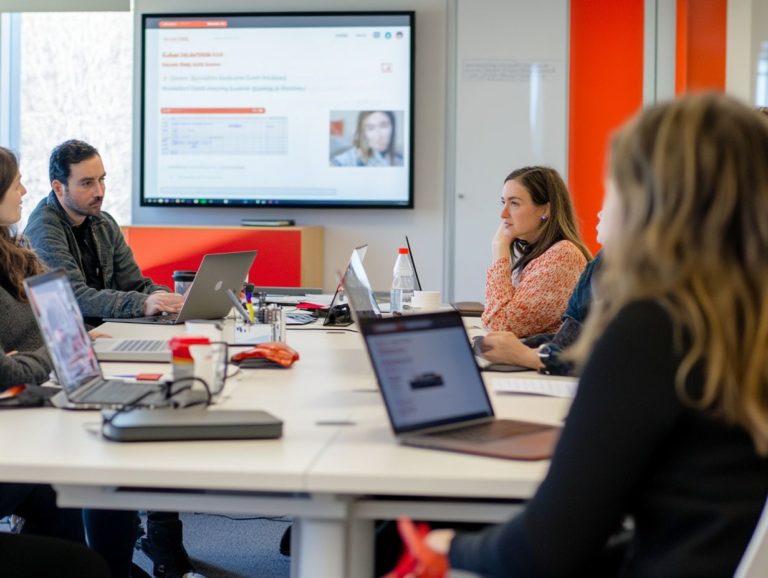What Is the Role of HR in Corporate Training?
In today s dynamic business landscape, corporate training is not just an option; it s a cornerstone for success. It delivers benefits to both employees and organizations alike.
This exploration delves into the critical role of Human Resources (HR) in crafting effective training programs. You ll see how HR identifies training needs, develops tailored curricula, collaborates across departments, and measures outcomes. Each responsibility is essential for cultivating a culture of continuous learning.
Uncover the strategies that pave the way for impactful training initiatives. These strategies propel organizational growth and ensure a thriving workforce.
Contents
- Key Takeaways:
- The Importance of Corporate Training
- The Role of HR in Corporate Training
- Designing Effective Training Programs
- Collaborating with Other Departments
- Measuring the Success of Training
- Frequently Asked Questions
- What Is the Role of HR in Corporate Training?
- Why is HR involved in corporate training?
- How does HR contribute to corporate training?
- What are the benefits of having HR involved in corporate training?
- What challenges does HR face in corporate training?
- How can HR ensure the success of corporate training programs?
Key Takeaways:

- HR plays a crucial role in corporate training by identifying training needs, designing effective programs, and collaborating with other departments.
- Effective training programs have numerous benefits for employees and organizations, such as increased productivity, job satisfaction, and retention.
- HR is responsible for measuring the success of training through key metrics and evaluation methods. This ensures that training aligns with business goals and effectively meets the needs of employees.
The Importance of Corporate Training
Corporate training is a key part of employee development. It also enriches the company culture, directly boosting productivity and engagement.
You must prioritize effective training programs now to ensure your team’s success! This approach ensures your workforce is well-prepared to tackle evolving business demands. By committing to ongoing training initiatives, you can significantly boost employee performance and satisfaction.
Benefits for Employees and Organizations
The advantages of corporate training resonate deeply with both employees and organizations. Customized training programs enhance skills, elevate job satisfaction, and bolster retention rates.
When you provide employees with opportunities for professional development, they feel genuinely valued. This makes them more likely to engage fully in their roles. Such a sense of investment lifts morale and translates into a higher quality of work, which positively reflects on the organization.
Organizations that prioritize effective training processes see significant returns. Engaged employees are less inclined to seek opportunities elsewhere. This leads to a more stable workforce for companies, enhancing overall performance.
In this environment, cultivating a culture of continuous learning advances individual career trajectories and fortifies the organizational structure.
The Role of HR in Corporate Training
Human Resources (HR) holds a crucial position in corporate training. It serves as a vital link between employees and the overarching goals of the organization.
By developing and managing impactful training initiatives, HR enhances workforce capabilities while ensuring alignment with the company’s strategic objectives. Through a meticulous assessment of both employee needs and organizational demands, HR professionals craft training programs that cultivate leadership skills.
This promotes continuous personal and professional development, thereby fostering a positive organizational culture.
In conclusion, effective corporate training is essential for success. The role of HR is crucial in achieving this, making it imperative for organizations to prioritize these initiatives now.
Responsibilities and Duties
HR plays a pivotal role in corporate training. They identify training needs, select the right resources, and oversee the implementation of programs that maximize engagement and effectiveness. Additionally, understanding what role managers play in employee training is crucial for success.
In this essential function, HR professionals conduct thorough assessments to uncover skills gaps among employees. This ensures that training initiatives align perfectly with both individual development and organizational objectives.
HR experts choose training methods and technologies that accommodate various learning styles, from hands-on workshops to interactive e-learning platforms.
An important aspect of their responsibilities involves evaluating the success of these programs through feedback and performance metrics. This paves the way for continuous improvement.
Best practices include crafting interactive sessions, promoting peer collaboration, and weaving in real-world scenarios. This approach enhances the learning experience and drives higher levels of participation.
Designing Effective Training Programs

Designing effective training programs requires a step-by-step method to curriculum development. This ensures participants can practically apply what they’ve learned in the workplace.
Start by identifying specific training needs through assessments. Then develop relevant materials that resonate.
Incorporating adult learning principles enhances engagement and ensures knowledge retention.
Identifying Training Needs
Identifying training needs is a vital first step in developing effective corporate training programs. It requires thorough analysis of skills gaps and performance assessments to align employees’ capabilities with organizational goals.
Consider conducting employee surveys to gather insights from your workforce. Utilize performance evaluations and seek feedback from management to assess current skill levels.
Engaging multiple perspectives ensures a well-rounded understanding of workforce needs. Aligning these training needs with organizational objectives enhances workforce development and propels business success.
Developing Curriculum and Materials
Developing curriculum and training materials is crucial for any corporate training program. Tailor them to meet specific learning objectives while accommodating diverse needs and learning styles.
The process of creating effective training content ensures that the content is relevant and captivates participants. Engaging and interactive training content enhances comprehension and retention.
Clearly defined learning objectives serve as the backbone of this process. They guide you in creating materials that are purposeful and meaningful.
These objectives streamline component development, ensuring alignment with overall training program goals. This ultimately contributes to the growth and effectiveness of your workforce.
Implementing and Evaluating Training
Implementing and evaluating training programs requires careful planning and execution. This ensures that learning objectives are met and that employees can effectively apply their newfound skills in the workplace.
Start by scheduling training sessions at convenient times for participants. Consider their availability and workload. Proper resource allocation is essential; selecting the right tools, materials, and facilities helps create an effective learning environment.
Engaging participants is key. Interactive methods such as group discussions, role-playing, and hands-on activities foster collaboration and enhance the learning experience.
After the training, utilize various evaluation methods like feedback surveys and performance metrics. These tools help assess the training s impact and effectiveness, allowing for continuous improvement through data-driven insights that guide future programs.
Collaborating with Other Departments
Collaboration with other departments is essential for the success of corporate training initiatives. It nurtures cross-departmental support and ensures training programs are both relevant and aligned with the organization s objectives.
Engaging closely with managers and team leaders helps pinpoint specific training needs. Together, you can implement tailored solutions that elevate employee engagement and performance throughout the organization.
Working with Managers and Team Leaders
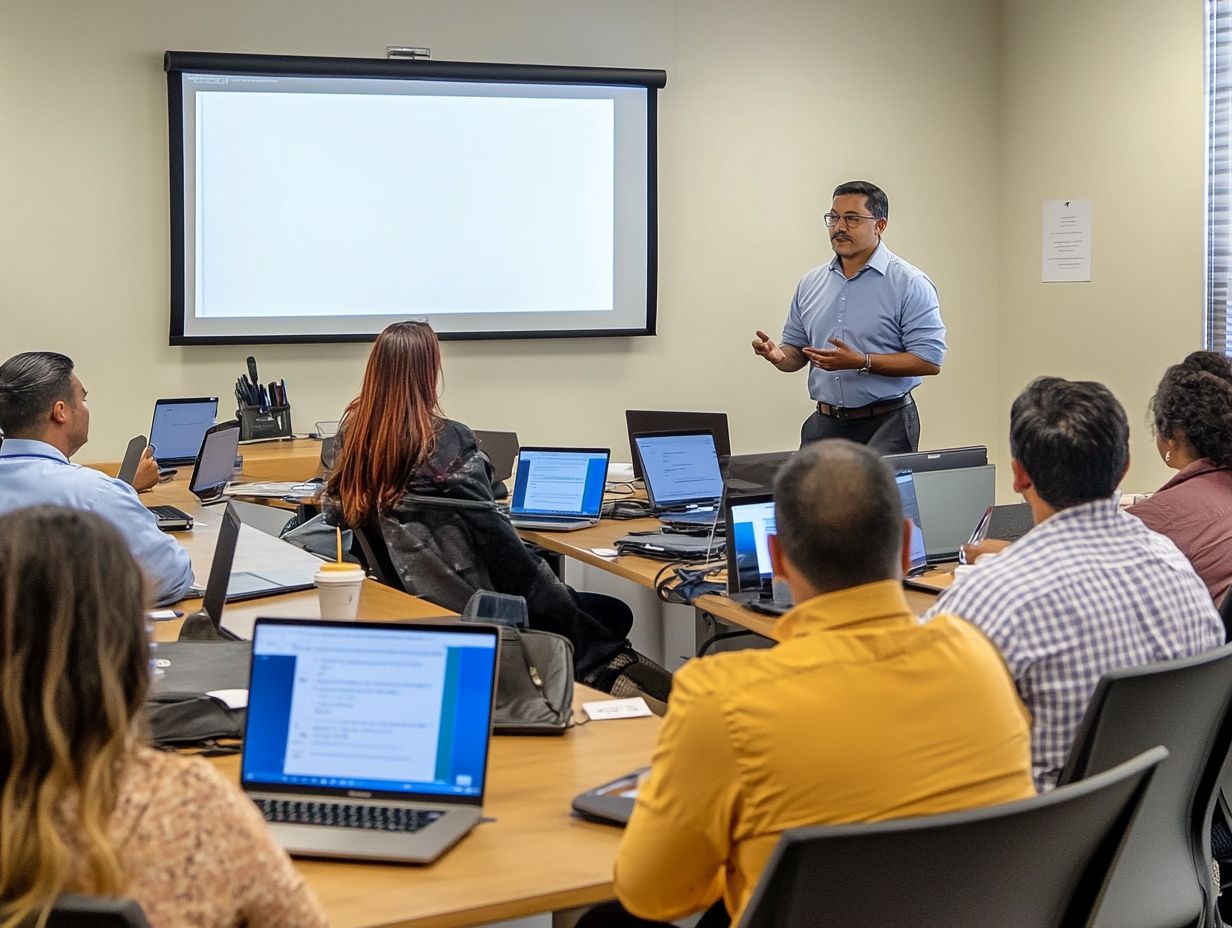
Collaborating closely with managers and team leaders is vital for effective training. They support their teams and provide essential feedback on training needs and outcomes.
Their involvement enriches the learning experience. It also fosters a culture of continuous improvement in the organization. By engaging with employees during training sessions, managers clarify objectives, motivate participants, and address any concerns that arise. This support nurtures accountability and ensures that lessons learned translate into real-world application.
Effective communication between HR and management is crucial for alignment. Regular updates and feedback loops enhance collaboration, making it easier to identify skill gaps and tailor training initiatives to meet specific needs.
Utilizing Technology and Resources
Embrace technology in your training programs to supercharge the learning experience! It grants employees access to digital resources and tools that help manage training online that actively support their ongoing development and engagement.
Incorporating various technologies, such as e-learning platforms, allows you to create tailored training modules that cater to diverse learning preferences. Imagine virtual classrooms fostering interactive environments where real-time communication between trainers and participants thrives this is especially beneficial for remote teams.
Mobile learning apps let employees train anytime, anywhere. This approach promotes ongoing skill development. By leveraging these advanced tools, you can effectively bridge skills gaps and ensure your workforce remains competitive. Ultimately, this leads to improved training outcomes and heightened employee satisfaction.
Measuring the Success of Training
Measuring the success of your training programs is essential for understanding their impact on employee performance and evaluating the return on investment (ROI) for your organization.
By utilizing a range of evaluation methods and key metrics, you can assess the effectiveness of your training initiatives and make informed, data-driven decisions for future programs.
Ready to transform your training approach? Start implementing these strategies today!
Key Metrics and Evaluation Methods
Key metrics and evaluation methods are crucial for assessing the effectiveness of training programs. They enable your organization to gauge employee performance and satisfaction after participation.
Utilizing employee feedback surveys is a vital part of this evaluation process. These surveys offer amazing insights that can transform training, providing direct feedback on participants’ experiences and perceptions.
Performance assessments, which measure how well employees do their jobs, can reveal areas of strength and weakness. This helps you pinpoint both strengths and weaknesses.
Post-training evaluations play a significant role in capturing immediate reactions and knowledge retention. By analyzing this data collectively, you can spot patterns and trends that inform future training initiatives, ensuring they are tailored, relevant, and impactful.
This assessment and adjustment cycle fosters a culture of continuous learning and development within your organization.
Frequently Asked Questions
What Is the Role of HR in Corporate Training?
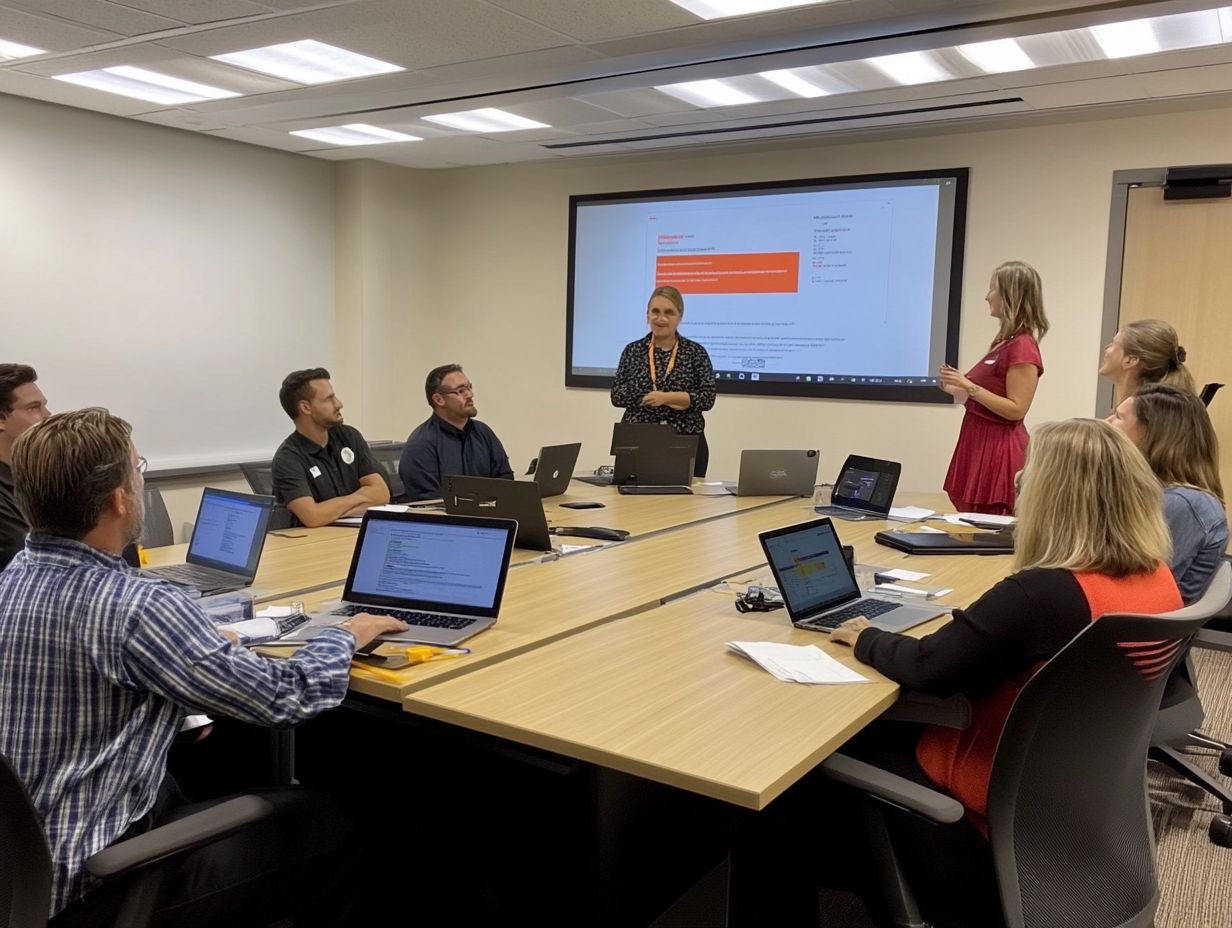
The role of HR in corporate training is to develop and implement effective training programs for employees that align with the company’s goals and objectives, while also considering what role trainers play in corporate training.
Why is HR involved in corporate training?
HR is involved in corporate training because they manage employee development, ensuring that employees have the necessary skills and knowledge to perform their jobs effectively.
How does HR contribute to corporate training?
HR contributes to corporate training by identifying training needs, sourcing training materials and resources, coordinating training sessions, and evaluating training effectiveness, while also understanding the role of mentorship in corporate training.
What are the benefits of having HR involved in corporate training?
Having HR involved in corporate training ensures training programs align with the company’s overall strategy and goals, providing employees with consistent and high-quality training.
What challenges does HR face in corporate training?
Some challenges HR may face in corporate training include limited resources, employee resistance, and difficulty measuring the impact of training on performance.
How can HR ensure the success of corporate training programs?
HR can ensure the success of corporate training programs by involving managers and employees in the training process, regularly evaluating and updating training programs, and providing ongoing support and resources for employees.



